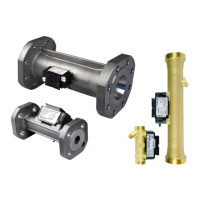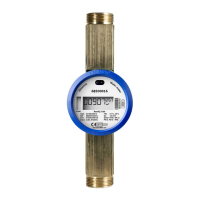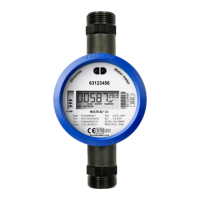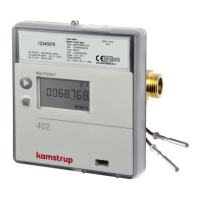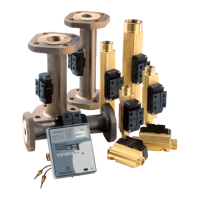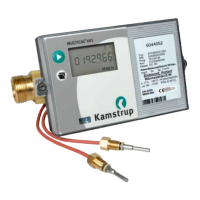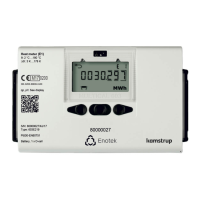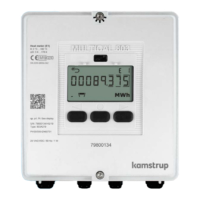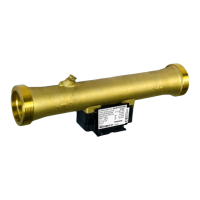Do you have a question about the Kamstrup 162M and is the answer not in the manual?
| Brand | Kamstrup |
|---|---|
| Model | 162M |
| Category | Measuring Instruments |
| Language | English |
Definitions of key terms used in the manual for clarity and understanding.
Details the physical design and components of the meter.
Outlines the different variants and models of the meter available.
Describes the initial sequence and displays shown upon powering the meter.
Explains the various internal registers for energy, power, and status data.
Details the types of energy (active, reactive) and their measurement quadrants.
Explains the methods used for calculating energy in three-phase meter configurations.
Describes registers used for testing and verification purposes in the meter.
Details registers that consumers can use to monitor consumption over periods.
Covers instantaneous and peak power measurements for all quadrants.
Lists miscellaneous registers including RTC, meter status, and tamper detection.
Explains the 8-digit status code indicating meter operational health.
Covers the meter's internal clock for time-based functions and data stamping.
Details the internal clock for accurate time stamping of data and events.
Describes the battery or supercap backup for the RTC and display.
Explains the register that tracks meter operating hours.
Covers the system for managing up to eight different tariffs based on time.
Explains the meter's capability to measure and register voltage quality parameters.
Describes how phase voltages are measured and used for quality analysis.
Details how the meter logs voltage deviations outside set limits.
Explains the logging of voltage interruptions and recoveries with timestamps.
Details how RTC is used for time stamping events like voltage failures.
Introduces the various loggers for data and event registration.
Covers the logger that stores data at defined debiting stop points.
Describes a secondary logger for debiting-related data with a different logging depth.
Explains the logger that records energy consumption at configurable intervals.
Details the logger for configurable register logging and analysis.
Describes the logger for internal errors and meter condition monitoring.
Details the logger that records changes and adjustments to the real-time clock.
Logs voltage failures on phases, including duration and recovery.
Records events related to the meter's disconnect functionality.
Logs neutral fault detection events in the supply network.
Covers the meter's I/O ports for external device communication.
Details the configuration of pulse inputs for tariff control or alarms.
Explains how pulse inputs are used for water meter readings.
Provides pulse value configurations for electricity meter readings.
Describes configuration options for pulse outputs.
Details the SO pulse output for energy consumption indication.
Explains the optional APS functionality for meter power.
Covers meter-generated alarms for events like magnetic detection or tamper.
Describes the module for controlling external installations via relays.
Describes the primary display area for register values and units.
Indicates the status of phase voltages, showing if they are within the minimum limit.
Shows current direction for each phase, useful for installation checks.
Displays the currently active tariff (T1-T8).
Indicates whether the internal breaker is connected or disconnected.
Details how to customize the readings displayed on the meter screen.
Explains the procedure for accessing load profile data via the display.
Discusses connecting to a radio network for remote data acquisition.
Explains the process of remotely updating the radio module software.
Explains how the meter can cut off the consumer's supply.
Describes how to manually disconnect or reconnect the meter using the push button.
Covers remote disconnection and reconnection via communication protocols.
Explains automatic disconnection based on current or power limits.
Describes the function for controlling supply based on prepaid energy credit.
Provides a state diagram illustrating the meter's disconnection states.
Explains specific disconnection behavior when APS is active.
Outlines standards and requirements for developing modules for the meter.
Describes the Kamstrup proprietary protocol for meter access and setup.
Lists the type approvals and standards the meter complies with.
Details electrical, mechanical, and environmental specifications.
Specifies terminal types, sizes, and tightening torque.
Describes the pin assignments and functions of the module interface.
Includes dimensional sketches for different meter types.
Provides a list of primary modules with their article numbers.
Mentions the availability and slot for secondary communication modules.
Explains the structure of the type number for ordering.
Details various configuration codes for meter settings and options.
Describes configuration options for display, LED, primary module, and integration period.
Details display configuration, target date, and debiting logger interval settings.
Covers disconnect setup, peak power, GMT, availability, and pulse input settings.
Explains plans for tariff control, load control, and daylight saving.
Details frequency settings for transmitting power.
Lists all possible readings that can be displayed on the meter.
Explains how to set up tariff and load control schedules.
Allows defining days of the week as working or non-working.
Configures periods for tariff changes based on start dates.
Sets up schedules for controlling load outputs (active/inactive).
Defines specific dates as exception days for tariff/load control.
Allows overriding the internal tariff plan with an OnDemand command.
Describes the variable delay applied when load control relays change state.
Specifies dates for changing between daylight and normal time.
Information required for creating custom meter labels.
A form for specifying meter display readings for auto/manual scroll.
Defines settings for smart disconnect, prepayment, and reconnection parameters.
Shows the terminal layout and numbering for different meter models.
Illustrates wiring diagrams for various meter configurations.
Details safety precautions and regulations for meter installation.
Describes the options for sealing the meter and its components for tamper protection.
